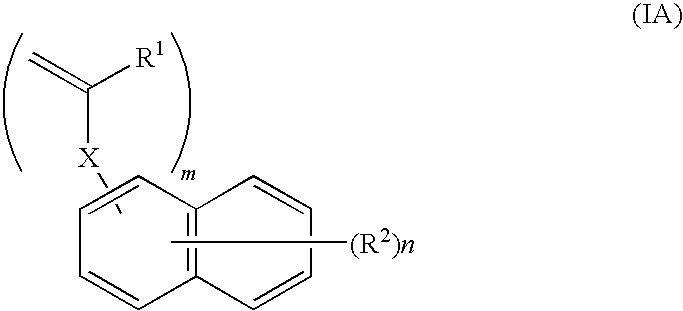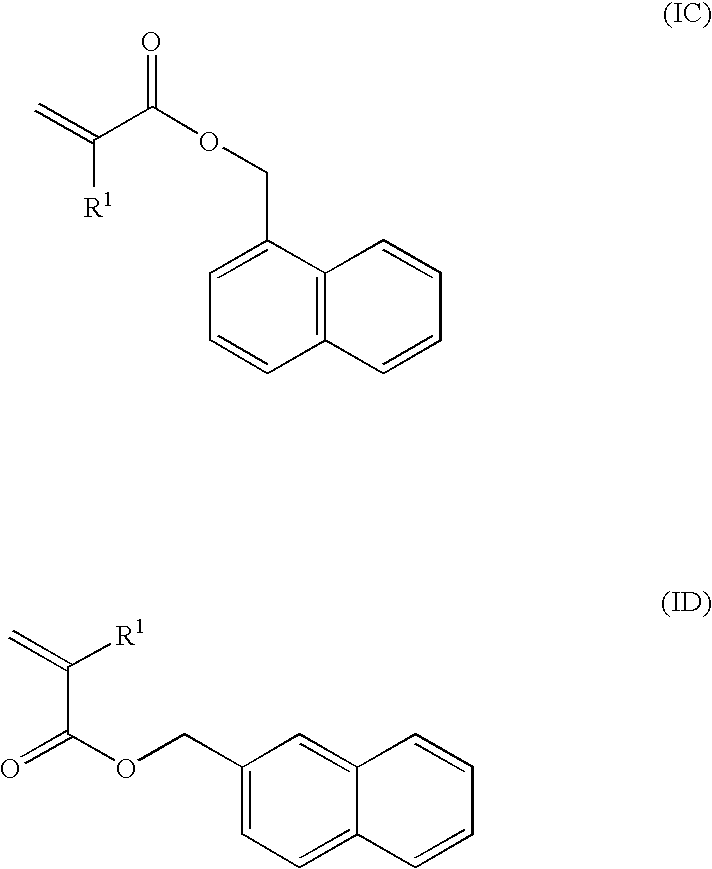Curable composition for nanoimprint, and patterning method
a composition and nano-imprint technology, applied in the field of curable composition for nano-imprints, can solve the problems of so-called magnetic field expansion, cost reduction and throughput increase, and difficult to satisfy all the three of micro-pattern resolution, and achieve the effects of enhancing mold-resist releasability, enhancing composition flowability, and hardly worsening mold transferability
- Summary
- Abstract
- Description
- Claims
- Application Information
AI Technical Summary
Benefits of technology
Problems solved by technology
Method used
Image
Examples
production example 1
Production of Compound (I-1A)
[0136]α-naphthol (150 g) was dissolved in ethyl acetate (600 ml), and triethylamine (158 g) was added thereto. With cooling with ice, acrylic acid chloride (113 g) was added to the solution, taking 1 hour. This was reacted at room temperature for 5 hours, and then water (100 ml) was added thereto and stirred for 1 hour. After stirred, the organic phase was washed with aqueous 1 N hydrochloric acid solution, and then washed with aqueous saturated sodium hydrogencarbonate solution and saturated saline water. The organic phase was dried with sodium sulfate, and then concentrated to give a crude product. This was purified through column chromatography to give the following compound (I-1A) (100 g). The compound (I-1A) was liquid at room temperature, and its viscosity at 25° C. was 27.8 mPa·s.
[0137]1H-NMR (CDCl3): δ6.1 (d, 1H), δ6.5 (dd, 1H), δ6.75 (d, 1H), δ7.3 (d, 1H), δ7.5 (m, 3H), δ7.8 (d, 1H), δ7.8-7.9 (m, 2H)
[0138]In the above-mentioned Production Exampl...
production example 2
Production of Compound (I-2A)
[0139]β-naphthol (70 g) was dissolved in acetone (400 ml), and triethylamine (69 g) was added thereto. With cooling with ice, acrylic acid chloride (53 g) was added to the solution, taking 1 hour. This was reacted at room temperature for 5 hours, and then water (300 ml) was added thereto and stirred for 1 hour. This was extracted twice with ethyl acetate, the organic phase was washed with aqueous 1 N hydrochloric acid solution, and then washed with aqueous saturated sodium hydrogencarbonate solution and saturated saline water. The organic phase was dried with sodium sulfate, and then concentrated to give a crude product. This was purified through column chromatography to give a compound (I-2A) (51 g).
[0140]1H-NMR (CDCl3): δ6.05 (d, 1H), δ6.4 (dd, 1H), δ6.65 (d, 1H), δ7.3 (d, 1H) δ7.5 (m, 2H), δ7.6 (s, 1H), δ7.8-7.9 (m, 3H)
production example 3
Production of Compound (I-3A)
[0141]1-Hydroxymethylnaphthalene (30 g) was dissolved in acetone (200 ml), and triethylamine (31 g) was added thereto. With cooling with ice, acrylic acid chloride (22 g) was added to the solution, taking 30 minutes. This was reacted at room temperature for 5 hours, and then water (100 ml) was added thereto and stirred for 1 hour. This was extracted twice with ethyl acetate, the organic phase was washed with aqueous 1 N hydrochloric acid solution, and then washed with aqueous saturated sodium hydrogencarbonate solution and saturated saline water. The organic phase was dried with sodium sulfate, and then concentrated to give a crude product. This was purified through column chromatography to give a compound (I-3) (32 g). The compound (I-3A) was liquid at room temperature, and its viscosity at 25° C. was 26.3 mPa·s.
[0142]1H-NMR (CDCl3): δ6.05 (d, 1H), δ6.4 (dd, 1H), δ6.65 (d, 1H), δ7.3 (d, 1H), δ7.5 (m, 2H), δ7.6 (s, 1H), δ7.8-7.9 (m, 3H)
PUM
| Property | Measurement | Unit |
|---|---|---|
| size | aaaaa | aaaaa |
| size | aaaaa | aaaaa |
| thickness | aaaaa | aaaaa |
Abstract
Description
Claims
Application Information
 Login to View More
Login to View More - R&D
- Intellectual Property
- Life Sciences
- Materials
- Tech Scout
- Unparalleled Data Quality
- Higher Quality Content
- 60% Fewer Hallucinations
Browse by: Latest US Patents, China's latest patents, Technical Efficacy Thesaurus, Application Domain, Technology Topic, Popular Technical Reports.
© 2025 PatSnap. All rights reserved.Legal|Privacy policy|Modern Slavery Act Transparency Statement|Sitemap|About US| Contact US: help@patsnap.com



